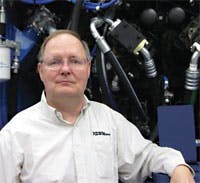editor
[email protected]
I met Pete Stroempl nearly 25 years ago. I was fairly new to the fluid power community, and my boss, Dick Schneider, thought it would be a good idea for me to join the local chapter of the Fluid Power Society. He must have figured that interest in and knowledge of fluid power technology would rub off on me if I rubbed elbows with a bunch of fluid power people. He certainly was right.
After attending just two meetings, I was asked to become an officer in the chapter. I did, and soon met Pete Stroempl, who at that time worked at Rexroth Mobile Hydraulics. Pete volunteered his time in helping plan meetings, seminars, and other events conducted by the chapter.
Then in 1997 Pete accepted a new job in Texas. He eventually became chief engineer and engineering manager, and retired earlier this year. Like most engineers, Pete wanted to know how things were made and why. The design of hydraulic hose became a topic of interest, but his full-time job denied him the time to feed his curiosity. However, once he retired, he was able to devote the time to pursue his passion.
Pete contacted me in August to tell me he had finished a paper and to ask if I’d be interested in publishing it. In an email, he wrote:
“I retired some months ago. However, one detail has always bothered me about how the hose guys designed the product. As an old hydraulics guy, I was not satisfied with how the hose guys did their force balance. However, I did not object because the design method worked.”
Pete’s paper examines widely accepted design assumptions about hydraulic hose reinforcement and suggests that hose may have more reinforcement than it needs. Adopting his method could lead to hose that is lighter, thinner, and more flexible without compromising strength.
I read through the manuscript, and I questioned whether it would have wide appeal to readers. After all, I expect none of our qualified readers design hydraulic hose. They specify, size, select, and buy it, but they don’t design it. But then I realized how much I learned about hose by reading Pete’s paper. It also raised a lot of questions. I found the material to be thought provoking, interesting, and informative. I hope you do, too. Read the article here.


